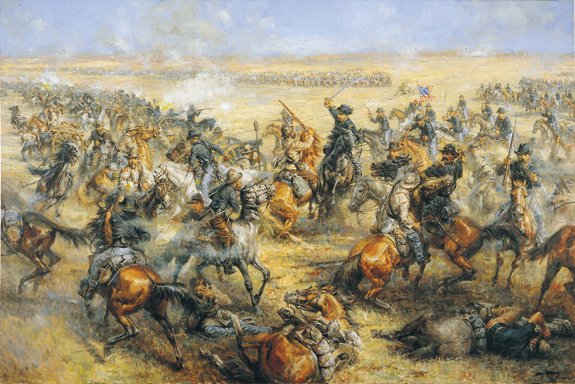Battle of Mine Creek


General Sterling Price had rallied his Confederate loyal soldiers in a last ditch effort to recruit for and resupply the faltering Army of Missouri. His late 1864 raid into Missouri was embarked upon with the intent of breathing new life into the dying Rebel Cause west of the Mississippi. The Union Army had organized, however, and they were stationed across the state, awaiting Price and forcing his rapid retreat. It was during his southward march, toward eventual safety in Arkansas, that Price’s forces began to fall apart. His sustained movement relied upon procuring Union supplies, and his battles across the state that autumn would require diversions into Kansas and Indian Territory, and the Union depots he aimed to plunder.
Price and his increasingly depleted, defeated army continued south, chased by his nemesis James Blunt and Union Major General Alfred Pleasanton. The Rebel forces entered Kansas in Linn County, and were camped on the northern banks of the Marais des Cygnes River. Exhausted from marching in the driving rain, and sleeping in snatches while propped up on their weapons, the Rebels hoped for a respite from the relentless Federal push.
Early on October 25, the Federals caught up with them. The Union Army came at the Confederates from the north, and a fast and hot artillery bombardment finally forced the Army of Missouri across the river, south toward Mine Creek. Later that day, the ragged Confederate forces, having crossed the Marais des Cygnes under duress that morning, were attacked by another Federal force as they continued their march southward. Just after crossing Mine Creek, the estimated 7000 Confederates, led by Brigadier General James F. Fagan and Brigadier General John S. Marmaduke, were assaulted by a mounted Federal force moving in from the south.
The speed of the attack didn’t allow for dismounting, making it one of the largest mounted cavalry fights of the Civil War. Thirty minutes after they attacked, the Federals had captured 600 Confederates, including Marmaduke and General William L. Cabell, as well as their cannons. Price, supported by “Jo” Shelby’s Iron Brigade, arrived in time to protect the retreat of his devastated forces. Said the verbose Shelby: “It was an evening to try the hearts of my best and bravest, and rallying around me they even surpassed all former days of high and heroic bearing…It was a fearful hour. The long and weary days of marching and fighting were culminating, and the narrow issue of life or death stood out all dark and barren as a rainy sea…Slowly, slowly my old brigade was melting away….”1
The day wasn’t over yet. As Price’s forces marched southward, they skirmished again with Federal forces as they tried to cross the swollen Marmiton River. Fighting continued until after dark, with Shelby deploying over 1000 men, mostly unarmed, in a desperate attempt to save the supply wagons. Price, his support system increasingly pinched, burned all the wagons, saving only those with military supplies. His future efforts, and those of the army he led, would focus on food and forage rather than recruitment and Union Army plunder.
Price’s Army never recovered from the terrible impact of the cavalry charge at Mine Creek, certainly one of the most dramatic of the war.2 The demoralized Army of Missouri continued their southward march, and each time they turned to fight the pursuing Union Army, they gave up more men, wagons, and supplies. Price’s men began to simply walk away. They deserted in droves, some into Federal camps for the food and medical attention they afforded, others to parts unknown, as far from the persistent battling as possible. Upon entering Indian Territory, many of the remaining bushwhackers and guerrillas who had fallen in with Price’s convoy remained in the relative safety of the military camp. Good riddance, said the most dogged of the Ozark citizens still in and near their homes.
On November 7, the ragged, exhausted Confederates crossed the Arkansas River and the Federals ceased any further pursuit. Price’s Army of Missouri, initially 12000 strong, had shrunk to just over 3000 by December. Price’s Raid, the last great Confederate offensive in the Trans Mississippi West, was in retrospect little more than a diversion to the Union Army and the war weary people in the Ozarks.
 Browse all collections in Battle of Mine Creek
Browse all collections in Battle of Mine Creek
- Alvin J. Josephy, The Civil War in the American West. (New York: Alfred A. Knopf, 1992), 384.
- Josephy, The Civil War in the American West, 384.












